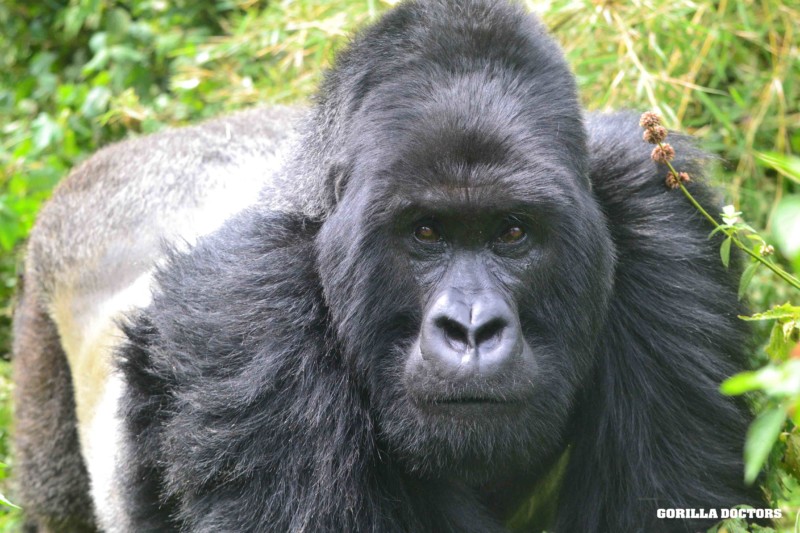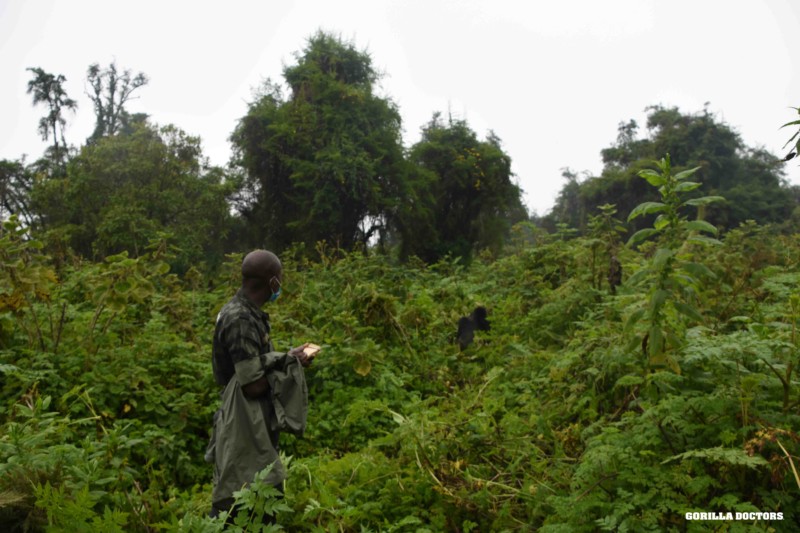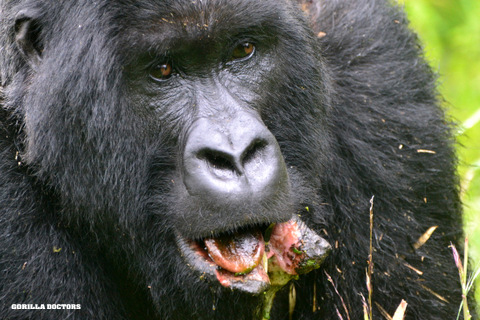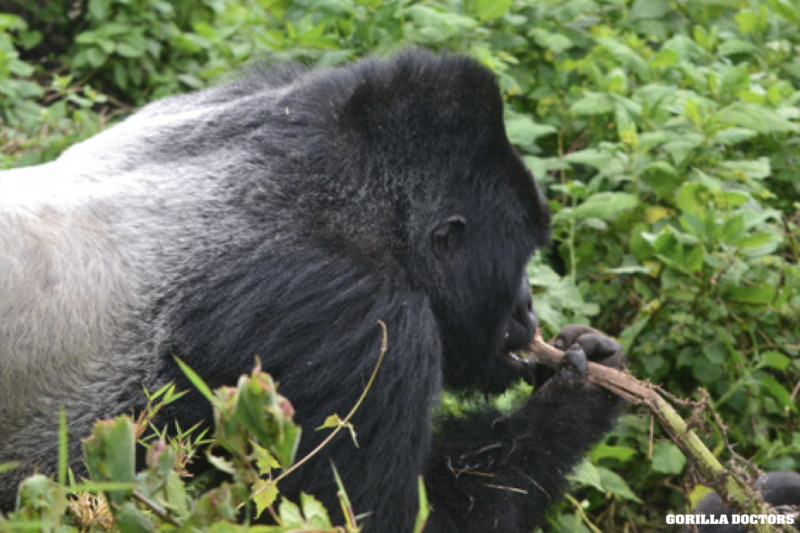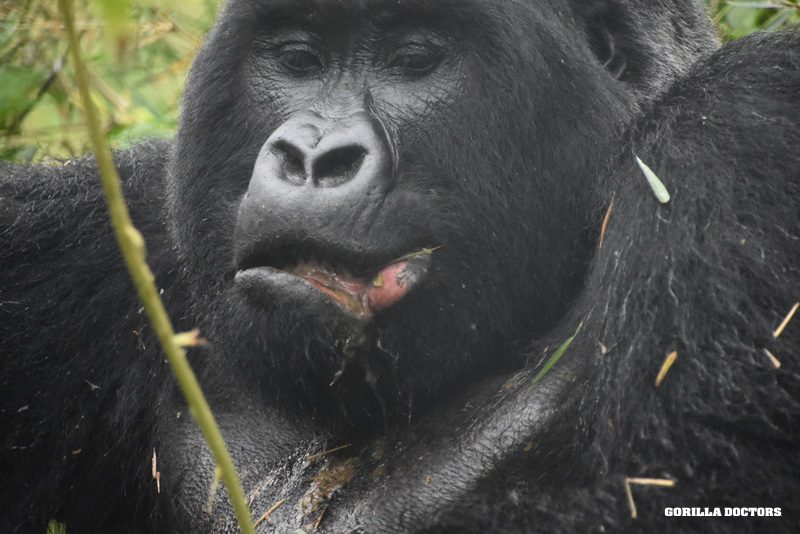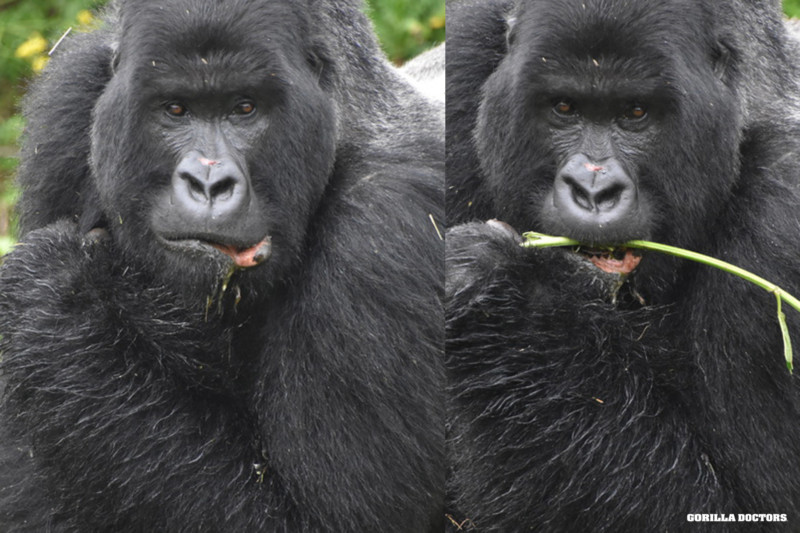The Remarkable Healing of Silverback Gihishamwotsi
By Gorilla Doctors Staff on Thursday, July 23rd, 2020 in Blog.Sabyinyo group had been out of range for about 10-days when Volcanoes National Park rangers first spotted their return to the area on May 25th. Dominant silverback Gihishamwotsi had clearly been in a fight, with wounds all over his body, so rangers immediately reported his condition to Gorilla Doctors. We mobilized for a veterinary monitoring visit the next morning. What follows is the story of Gihishamwotsi’s extraordinary healing that occurred naturally, without the need for a clinical intervention by Gorilla Doctors…
SUMMARY OF GIHISHAMWOTSI’S MONITORING AND RECOVERY
Location: Volcanoes National Park, Rwanda
Gorilla Group: Sabyinyo
Gorilla: Silverback Gihishamwotsi
Gorilla Doctors: Drs. Jean Bosco ‘Noel’ Noheri and Gaspard Nzayisenga
Start Date: May 25, 2020
End Date: July 6, 2020 (with continued monitoring)
Silverback Gishishamwotsi has been leading Sabyinyo group for several years, having taken over from his father Guhonda, who recently left Sabyinyo group with an adult female and her infant. On May 15th, Volcanoes National Park rangers first reported that Sabyinyo group had moved out of range, and the group was not seen again until May 25th. Park rangers believe that during the time Sabyinyo group was out of range, sometime between May 16th and May 24th, Gihishamwotsi fought with either an unknown group or a lone silverback. Several other members of the group also sustained superficial wounds, none of which were serious or showing signs of infection. Rangers immediately notified Gorilla Doctors.
May 26th – Dr. Noel conducted the first of many monitoring visits of Sabyinyo group, and in particular noted that Gihishamwotsi was most severely affected, with superficial bite wounds all over his body. The most extreme wound was to his lower lip, which had essentially been lacerated down the middle, with each side of his lower lip hanging open. Dr. Noel estimated the laceration to be approximately 15cm in length, and it was clearly impacting Gihishamwotsi’s ability to feed. He was also lethargic and demonstrating clinical signs of pain.
Dr. Noel noted that while Gihishamwotsi’s injury was not life-threatening, it would remain to be seen if the two sections of his split lip would heal back together completely on their own or if an intervention might be necessary – close daily monitoring would continue.
May 27th – Dr. Noel returned for a second monitoring visit and observed that while Gihishamwotsi was still lethargic and in pain, his feeding and activity were already improving and his lip wound showed no sign of infection.
May 29th – Dr. Gaspard conducted a follow-up monitoring visit of Gihishamwotsi and observed that the silverback was feeding and his activity almost returned to normal. There continued to be no sign of infection of the wounded lip, and the individual wound edges appeared to be healing, so no clinical intervention was scheduled. Dr. Gaspard noted the rest of Sabyinyo group was in general good health.
Over the next several days, park rangers continued daily monitoring of Sabyinyo group and Gihishamwotsi’s condition, reporting to Gorilla Doctors that healing was slow but steady.
June 10th – Dr. Gaspard returned to Sabyinyo group to see that there had been significant improvement of Gihishamwotsi’s lip, with reduced swelling, and the lip wound edges beginning to come together and no signs of infection. Gihishamwotsi was actively feeding and did not appear to have lost weight or body condition, despite the trauma to his mouth.
June 18th – Dr. Noel’s monitoring visit at about the 3-week point after first observing Gihishamwotsi’s traumatic wound was encouraging: Gihishamwotsi’s lip was healing well, suggestive of a full recovery.
July 6th – After 44-days since the first report of injury, Dr. Noel was thrilled to find that Gihishamwotsi’s lip was almost fully healed.
A Note from our Executive Director
Given that our mountain gorilla patients are wild, an important part of Gorilla Doctors’ mission is to intervene only when a condition is life-threatening or likely human-caused. As veterinarians dedicated to the health and wellness of these magnificent animals, it can be difficult for us to stand back and observe these types of serious injuries. However, it is equally extraordinary to observe the remarkable ability of gorillas to self-heal.
In mountain gorillas and other wildlife, it is not uncommon to examine an animal and discover that it had suffered but survived a traumatic injury earlier in life (e.g. limb fracture). Animals (and humans!) bodies have evolved very powerful physiologic mechanisms and adaptations for responding to injury and illness. Might some animals be more successful than others at recovering from wounds like the ones sustained by Gihishamwotsi? An interesting study that examined social status and wound healing in wild baboons found that higher-ranking males recovered from illness more quickly, and that alpha males with the highest levels of testosterone and reproductive effort (often associated with rank in baboons) healed from their wounds faster than other males (both high and low-ranking)1. Perhaps Gihishamwotsi’s social status and physiology contributed to his remarkable recovery and healing.
1Altmann, J. et al., Social status predicts wound healing in wild baboons. PNAS 109 (23): 9017-9022


 Donate
Donate
